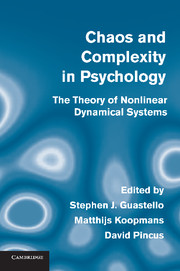Book contents
- Frontmatter
- Contents
- Contributors
- Preface
- 1 Introduction to Nonlinear Dynamics and Complexity
- 2 Collective Intelligence: Observations and Models
- 3 Neurodynamics and Electrocortical Activity
- 4 Psychophysics
- 5 Temporal and Spatial Patterns in Perceptual Behavior: Implications for Dynamical Structure
- 6 Embodied and Embedded: The Dynamics of Extracting Perceptual Visual Invariants
- 7 Origins of Order in Cognitive Activity
- 8 Nonlinear Complex Dynamical Systems in Developmental Psychology
- 9 Developmental Psychopathology: Maladaptive and Adaptive Attractors in Children's Close Relationships
- 10 Psychopathology
- 11 Coherence, Complexity, and Information Flow: Self-Organizing Processes in Psychotherapy
- 12 The Dynamics of Human Experience: Fundamentals of Dynamical Social Psychology
- 13 Group Dynamics: Adaptation, Coordination, and the Emergence of Leaders
- 14 Organizational Psychology
- 15 Complexity, Evolution, and Organizational Behavior
- 16 Agent-Based Modeling Within a Dynamic Network
- 17 Epilogue: Psychology at the Edge of Chaos
- Index
11 - Coherence, Complexity, and Information Flow: Self-Organizing Processes in Psychotherapy
Published online by Cambridge University Press: 18 December 2013
- Frontmatter
- Contents
- Contributors
- Preface
- 1 Introduction to Nonlinear Dynamics and Complexity
- 2 Collective Intelligence: Observations and Models
- 3 Neurodynamics and Electrocortical Activity
- 4 Psychophysics
- 5 Temporal and Spatial Patterns in Perceptual Behavior: Implications for Dynamical Structure
- 6 Embodied and Embedded: The Dynamics of Extracting Perceptual Visual Invariants
- 7 Origins of Order in Cognitive Activity
- 8 Nonlinear Complex Dynamical Systems in Developmental Psychology
- 9 Developmental Psychopathology: Maladaptive and Adaptive Attractors in Children's Close Relationships
- 10 Psychopathology
- 11 Coherence, Complexity, and Information Flow: Self-Organizing Processes in Psychotherapy
- 12 The Dynamics of Human Experience: Fundamentals of Dynamical Social Psychology
- 13 Group Dynamics: Adaptation, Coordination, and the Emergence of Leaders
- 14 Organizational Psychology
- 15 Complexity, Evolution, and Organizational Behavior
- 16 Agent-Based Modeling Within a Dynamic Network
- 17 Epilogue: Psychology at the Edge of Chaos
- Index
Summary
The True Nature of Psychotherapy
What is psychotherapy? This simple question can stimulate hours of discussion, producing more new questions for each new answer. For example, one may ask if there is a single answer to what psychotherapy is, or if in fact psychotherapy is always different for each unique client. Probing deeper, one may also wonder if scientifically informed “theories” of psychotherapy really add to the “truth” of what therapy is for any given client, or whether truth is actually derived through a constructive process. Such questions raise the question of the merits of “truth” versus “utility,” as even the most scientifically controlled or “manualized” approaches to treatment encourage the therapist to accommodate any approach to fit the values, goals, and unique situations of the client. It appears that defining psychotherapy is a difficult matter, creating practical and scientific questions that are worthy of deep exploration.
Psychotherapy has a great tradition of such deep self-examination. For example, Frank and Frank (1991) have influenced two generations of therapists with the well-reasoned yet apparently controversial suggestion that modern psychotherapy is based more on applied rhetoric than on scientific discovery. The psychotherapy field has generally been forced to conclude that factors common across approaches are better predictors of treatment outcome than are the use of a specific technique (Orlinsky & Howard, 1995), particularly the quality of the therapist–client relationship (Orlinsky, Grawe, & Parks, 1994).
Information
- Type
- Chapter
- Information
- Chaos and Complexity in PsychologyThe Theory of Nonlinear Dynamical Systems, pp. 335 - 369Publisher: Cambridge University PressPrint publication year: 2008
Accessibility standard: Unknown
- 3
- Cited by
